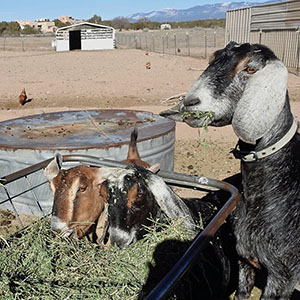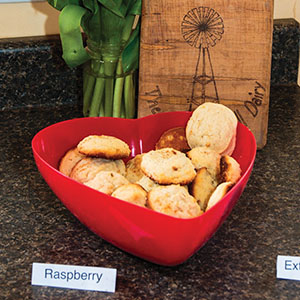Extreme diversity distinguishes the southwest from other U.S. Regions. I-40 (old Route 66) splits the Southwest into two distinct environments: the northern divide has cool climates, tall pines and mountainous terrain, for example, in Santa Fe and Flagstaff. The southern divide is hot, flat and arid, like Albuquerque and Phoenix. A short one hour drive from Albuquerque to Santa Fe provides an unmistakable illustration of the difference in environment.
As you zip along I-25, your ears pop from the 2,500-foot change in altitude and the temperature drops at least 4 degrees. Mountains spring up before your eyes. Two different worlds.
New Mexico is a Southwest state, but it’s a world apart in many ways. It has its own distinct blend of cultures, fashions, cuisine—and especially its own cheeses. With New Mexicans’ penchant for adding a dash of chile to everything from beer to chocolate, as well as an abundance of native fruits and herbs to add local flavor, you’ll find New Mexico’s artisanal goat cheeses delightfully different from those made elsewhere.

Old Windmill Dairy
Business partners Ed and Michael Lobough, co-owners of Old Windmill Dairy, located in central New Mexico’s Estancia Valley, about an hour from Santa Fe, are artisan goat cheese makers who understand New Mexico’s affinity for food with a bite. They produce cheeses—from Brie to Blue—that reflect the Southwestern palate.
The Loboughs are somewhat unlikely cheesemongers. It was after the 9/11 tragedy that life changed for them, as they sought a more personal connection to their professional lives. With corporate America seeming to lose sight of the human side of production, Ed and Michael wanted to return to nature, to create a life filled with purpose. In 2001, Michael, a hospitality industry executive, and Ed, a health care professional, decided to start a goat dairy. Because they had no experience, this new venture was a trial-and-error endeavor that required a high level of endurance and stamina.
Ed and Michael split their dairy duties. Ed took on the role of R&D manager and became the “culture” chef, combining different strains of cultures with chiles and fruits to imbue the cheese with that unique Southwestern flavor. Once Ed develops the culture combo, he turns the profile over to Michael for implementation. New cultures are used with every batch of milk in order to maintain the integrity of the rennet. Old Windmill takes pride in using vegetable rennet, which enables even lacto-ovo vegetarians to enjoy their cheeses.
Old Windmill’s cheeses fall into three major categories: aged, fresh and soft ripened. The Sandia Sunrise Smoked Gouda is an award-winning aged cheese. In the fresh category, Chili & Hot Chèvre exemplifies the New Mexico food culture. And in the soft-ripened category, my personal favorite is the Taos Truffle Brie, with its creamy spreadability and slight tang.
According to Michael, controlling the goats’ environment is the secret to producing a great-tasting cheese. “Whether it’s the alfalfa or naturally-occurring events, the environment is what influences the taste of our cheese,” he says. Old Windmill’s hundred-strong herd of goats dines on lush alfalfa grown in the Estancia Valley. Michael contracts with a local alfalfa grower to maintain a consistent feed product.
Mother Nature plays a leading role in the taste of the cheeses, as well. In May 2008, the Trigo Fire broke out in the Manzaño mountains, burning 21 square miles of ponderosa pine and piñon. This devastation of the plant life altered the weather pattern in the valley, which resulted in the introduction of a naturally-occurring blue mold to the air. Cheese, in particular, attracts and absorbs odors—Michael makes sure the bucks are kept downwind from the milkers because their musky scent permeates the air and changes the flavor of the cheese—but this particular mold actually enhances the taste with a flavor unique to the region.
The milk contains no hormone enhancement or additives. If a goat becomes ill and must be given antibiotics, she is pulled from milking until they are out of her system, because antibiotics prevent the milk from coagulating.
Ed and Michael’s original purpose was to produce fine cheeses, but they saw other opportunities, as well. One of their goals is to bring back the “front porch social” by opening their farm to the community, similar to an earlier time in American culture when people routinely gathered on the front porch in the evenings to visit with their neighbors. By bringing in the community, they seek to promote an awareness of where food comes from. “Cheese doesn’t begin in a plastic wrapper in the dairy section of the grocery store,” says Ed. “Young people need to understand the birthing process and how to care for the animals.” Children are allowed to hold and cuddle the goats, and Ed and Michael hope that activities like this can help refocus young people so that they can socialize again, rather than isolating themselves with their phones.
Other outreach efforts include a five-hour cheesemaking class offered each quarter in which students learn about the farm and cheesemaking through hands-on activities. Michael found another way to help the community is through the Workforce Connection, a job-matching service that pairs young people ages 19 to 26 with employers to acquire practical skills. Old Windmill is currently contracted with a young woman to work in the milk production area, and it has turned out to be beneficial to all concerned. She learns new skills, while Old Windmill gets needed help and the community has another productive citizen.
Old Windmill specializes in small batches, so you’re not likely to find their cheeses at mainstream supermarkets. They do sell to the local Santa Fe Whole Foods Market, but otherwise their wares are available on-site, at specialty stores in Santa Fe and online. They also supply several high-end restaurants in New Mexico.
Old Windmill Cheese is available at Whole Foods in New Mexico; Cheesemongers of Santa Fe; the Santa Fe Farmers Market; and online at oldwindmilldairy.com.

Dream Catcher Ranchito
As artisan cheese has grown in popularity, a number of goat farms have joined the push to produce hyper-local products that capitalize on New Mexico’s unique opportunities.
Mary Ann Andrews, owner of Dream Catcher Ranchito, a five-acre ranch located 30 minutes from Santa Fe, began her goat cheese dairy 10 years ago. Her top priority has always been the quality and care of the animals. For her, the mental health of the goats is as important as their physical health. Her motto is “A happy goat produces a better product.” The 50 goats at Dream Catcher benefit from what Andrews calls the “synergy between man and animal.” The goats are treated with respect, love and gratitude.
The majority of Andrews’ goats are Nubian, a breed originally found in northern Africa and characterized by their long ears. They are fed a top-quality diet of alfalfa with no extraneous foodstuffs, and they drink only pristine well water. Andrews sources her alfalfa locally, so she is able to honor her pledge to use no pesticides or chemical fertilizers. The combination of love and a controlled environment produces milk with a high butterfat content of about 24 percent. The higher the butterfat, the creamier the cheese.
Dream Catcher produces Greek and semi-tart, old-fashioned Bulgarian yogurt in addition to various types of cheeses, which include Chèvre, Ricotta, farm and Feta. One cheese blend in particular, Lemon Curd, is a consumer favorite. It’s made with organic eggs from the ranch’s own free-range chickens. To create this delightful blend of creamy and tart, Andrews uses Chèvre, organic lemon juice, chicory root instead of sugar, butter and organic eggs.
Andrews sponsors a volunteer program for families who commit to one day each week to interact with the animals and learn about the cheese making process.
Dream Catcher Ranchito cheese is available online at dreamcatcherranchito.com as well as at the weekend farmers market in Santa Fe.

Coonridge Organic Goat Cheese Ranch
“We strive to always live in harmony with the natural world that supports us all.” —Nancy Coonridge, owner of the only organic certified goat cheese producer in New Mexico.
In 1982, Nancy and Andy Coonridge left California in an old blue school bus to search for land to fulfill Nancy’s dream of owning a goat farm. They found the perfect location in northwestern New Mexico between Pie Town and Acoma Pueblo. At an elevation of 8,000 feet, Nancy and Andy established Coonridge Organic Goat Cheese Ranch. New Mexico’s arid terrain was the perfect place for her Alpine, Nubian and La Mancha goats, which quickly adapted to the rough terrain and climate.
Nancy’s herd of 25 to 30 milk goats are truly free-range. The does are milked each morning, then released into the wild under the guardianship of the Maremma sheepdogs. During the day, the goats, which wear electronic trackers, roam the countryside, foraging on sage, juniper and pine needles as well as organic feed when needed. The goats live as natural an existence as possible. During the winter when natural food is scarce, Nancy supplements their diet with alfalfa and hay. This gives the cheeses different seasonal flavors.
Nancy begins the cheesemaking by processing her fresh goat milk using vegetable rennet, separating the curds and whey, and placing the curds onto cheesecloth-lined trays. The cheese “bags” are hung on hooks to drain for a couple of days. Then, Nancy selects from 15 different herbs and garlic blends, which are added to the cheese. Finally, the cheese is packed into a jar, covered with organic oil, which “gives the cheese shelf life and intensifies the wonderful flavors.” Finally, the jars are labeled and ready for purchase. Throughout the cheesemaking process, Nancy keeps in mind her overriding philosophy: “Turning milk into cheese is alchemy, but the goats are the reason I do it.”
Coonridge Cheese is available at www.coonridge.com.

Pairing Local Cheeses With Local Wines
Wine and cheese are an age-old pairing for a reason; taken together, they enhance each other’s subtleties and intensify the flavors. New Mexico has been a wine-producing region since the 1500s, when Franciscan priests first brought their wine grapes from Spain to ensure a steady supply of altar wine and brandy. Since then, New Mexico wines have earned a reputation for quality and value—a perfect accompaniment to the region’s unique cheeses.
One of Old Windmill’s best sellers, Chili and Hot cheese, pairs well with Black Mesa Winery’s Malvasia Bianca, a fruity white that tempers the heat of the spicy cheese. Because chile peppers are technically fruits, they go well with fruity wines that bring out the subtle sweetness. Another popular matchup is Black Mesa’s 2014 Zinfandel and Old Windmill’s Holy Chipotle. This red wine is the perfect counterpart to the red chili, which is sometimes hotter than the green.
Dream Catcher Ranchito’s Lemon Feta is marinated with rosemary, thyme, herbs de Provence, lemon and olive oil, then paired with Black Mesa’s Viognier, which is made from white grapes grown in Southern New Mexico near Deming. The full-bodied fruitiness of the Viognier enhances the herbs and citrus of the Lemon Feta.
Coonridge’s Flame Roasted Green Chile, a cheese with a traditional New Mexico bite, was paired with Black Mesa’s Conejito White. A hundred percent of the grapes for the Conejito White are produced at the Black Mesa estate in Velarde, NM. This wine has body and structure; its sweetness balances the heat of the green chile.

Aimee Kuckartz’s Yummy Chèvre Cookie Recipe
5 oz Old Windmill Dairy Chili ’n’ Hot Chèvre*
1 cup shortening
1 cup sugar
2 egg yolks
2 cups flour
½ tsp salt
1 tsp vanilla
• Preheat oven to 350 degrees
• Cream together the Chèvre and shortening
• Add sugar, egg yolks, flour, salt and vanilla and mix thoroughly
• Drop small teaspoons of the batter onto an ungreased cookie sheet
• Bake 13-15 minutes until golden around the edges
*Substitute any of the Old Windmill Dairy Chèvres or cream cheeses, such as ExtraOrdinaire, Figs ‘N Cream or Holiday Delight



